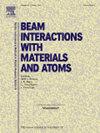同时离子辐照熔盐腐蚀实验中光束加热方式影响的有限元分析
IF 1.4
3区 物理与天体物理
Q3 INSTRUMENTS & INSTRUMENTATION
Nuclear Instruments & Methods in Physics Research Section B-beam Interactions With Materials and Atoms
Pub Date : 2025-04-16
DOI:10.1016/j.nimb.2025.165694
引用次数: 0
摘要
采用有限元方法研究了不同质子束辐照条件下316L不锈钢膜与熔盐环境接触时的温度和应力分布。结果表明,除了不均匀的辐照分布外,聚焦的2 MeV质子束会导致膜中非常强的温度和应力梯度,引入高度局部化的驱动力,使腐蚀研究实验结果复杂化,甚至损害其完整性和可靠性。在腐蚀研究中使用聚焦光束可能会产生可能歪曲真实腐蚀行为的实验伪影。相比之下,使用光栅光束可以均匀地分布质子和辐射损伤,更重要的是,温度和应力分布不仅非常均匀,而且幅度更小。因此,建议在熔盐腐蚀实验中使用光栅梁来实现均匀的损伤速率,从而降低温度和应力分布的梯度和幅度。本文章由计算机程序翻译,如有差异,请以英文原文为准。
Finite element analysis of the impact of beam heating mode in molten salt corrosion experiments employing simultaneous ion irradiation
Finite element analysis was used to investigate the temperature and stress profiles that develop in 316L stainless steel membranes being irradiated using different proton beam conditions in contact with a molten salt environment. It was shown that in addition to a nonuniform irradiation profile, a focused 2 MeV proton beam leads to very strong temperature and stress gradients in the membrane, introducing highly localized driving forces that complicate and even compromise the integrity and reliability of the experimental results of corrosion studies. The use of a focused beam in corrosion studies can create experimental artifacts that may misrepresent the true corrosion behavior.. In contrast, the use of a rastered beam is shown to distribute the protons and resulting radiation damage uniformly across the membrane face, and more importantly, results in temperature and stress profiles that are not only very uniform but are of much lower magnitude. The use of a rastered beam during molten salt corrosion experiments is therefore recommended to achieve uniform damage rates, thereby reducing both gradients and magnitudes of the temperature and stress distributions.
求助全文
通过发布文献求助,成功后即可免费获取论文全文。
去求助
来源期刊
CiteScore
2.80
自引率
7.70%
发文量
231
审稿时长
1.9 months
期刊介绍:
Section B of Nuclear Instruments and Methods in Physics Research covers all aspects of the interaction of energetic beams with atoms, molecules and aggregate forms of matter. This includes ion beam analysis and ion beam modification of materials as well as basic data of importance for these studies. Topics of general interest include: atomic collisions in solids, particle channelling, all aspects of collision cascades, the modification of materials by energetic beams, ion implantation, irradiation - induced changes in materials, the physics and chemistry of beam interactions and the analysis of materials by all forms of energetic radiation. Modification by ion, laser and electron beams for the study of electronic materials, metals, ceramics, insulators, polymers and other important and new materials systems are included. Related studies, such as the application of ion beam analysis to biological, archaeological and geological samples as well as applications to solve problems in planetary science are also welcome. Energetic beams of interest include atomic and molecular ions, neutrons, positrons and muons, plasmas directed at surfaces, electron and photon beams, including laser treated surfaces and studies of solids by photon radiation from rotating anodes, synchrotrons, etc. In addition, the interaction between various forms of radiation and radiation-induced deposition processes are relevant.

 求助内容:
求助内容: 应助结果提醒方式:
应助结果提醒方式:


